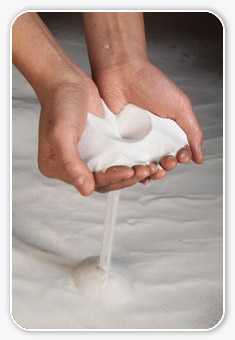
|
PRODUCTS | Barite/Baryte  | Dolomite | Dolomite  | Silica Sand | Silica Sand  | Limestone | Limestone  | Zinc / Silver / Copper | Zinc / Silver / Copper  | Iron ore | Iron ore  | Coal | Coal 
SILICA SAND (SiO2)
General Information
 Silica (silicon dioxide, SiO2) occurs as the mineral quartz, a major constituent in many igneous and sedimentary rocks, and the most common detrital mineral in sandstone. As a commodity, the term silica is applied to quartz in all its forms -- as vein or reef quartz, quartz pebbles, sandstone, quartzite, or as unconsolidated sand. World consumption approximates 120 Mt/year. Quartzite, sand and gravel used for construction purposes are excluded from this category. Silica (silicon dioxide, SiO2) occurs as the mineral quartz, a major constituent in many igneous and sedimentary rocks, and the most common detrital mineral in sandstone. As a commodity, the term silica is applied to quartz in all its forms -- as vein or reef quartz, quartz pebbles, sandstone, quartzite, or as unconsolidated sand. World consumption approximates 120 Mt/year. Quartzite, sand and gravel used for construction purposes are excluded from this category.
 Silica sand (industrial sand) is a high-purity quartz (SiO2) sand deposited by natural processes. Depending on its chemical and physical characteristics, silica sand is used as glass sand, foundry sand, abrasives, fillers, and hydraulic fracturing sand (also termed "frac" sand by the petroleum industry). Silica sand (industrial sand) is a high-purity quartz (SiO2) sand deposited by natural processes. Depending on its chemical and physical characteristics, silica sand is used as glass sand, foundry sand, abrasives, fillers, and hydraulic fracturing sand (also termed "frac" sand by the petroleum industry). |
 |
 Industrial sand is a term normally applied to high purity silica sand products with closely controlled sizing. It is a more precise product than common concrete and asphalt gravels. Silica is the name given to a group of minerals composed solely of silicon and oxygen, the two most abundant elements in the earths crust. In spite of its simple chemical formula, SiO2 , silica exists in many different shapes and crystalline structures. Found most commonly in the crystalline state, it also occurs in an amorphous form resulting from weathering or plankton fossilization. Quartz is the most common silica crystal and the second most common mineral on the earth's surface. It is found in almost every type of rock; igneous, metamorphic and sedimentary. While quartz deposits are abundant, and quartz is present in some form in nearly all mining operations, high purity and commercially viable deposits occur less frequently. Silica sand deposits are most commonly surface-mined in open pit operations, but dredging and underground mining are also employed. Extracted ore undergoes considerable processing to increase the silica content by reducing impurities. It is then dried and sized to produce the optimum particle size distribution for the intended application. Industrial sand is a term normally applied to high purity silica sand products with closely controlled sizing. It is a more precise product than common concrete and asphalt gravels. Silica is the name given to a group of minerals composed solely of silicon and oxygen, the two most abundant elements in the earths crust. In spite of its simple chemical formula, SiO2 , silica exists in many different shapes and crystalline structures. Found most commonly in the crystalline state, it also occurs in an amorphous form resulting from weathering or plankton fossilization. Quartz is the most common silica crystal and the second most common mineral on the earth's surface. It is found in almost every type of rock; igneous, metamorphic and sedimentary. While quartz deposits are abundant, and quartz is present in some form in nearly all mining operations, high purity and commercially viable deposits occur less frequently. Silica sand deposits are most commonly surface-mined in open pit operations, but dredging and underground mining are also employed. Extracted ore undergoes considerable processing to increase the silica content by reducing impurities. It is then dried and sized to produce the optimum particle size distribution for the intended application.
 |
Applications
 The silica sand used in making glass has the most rigid industry-based specifications. Tiny amounts of impurities, such as iron, manganese, chromium, calcium, or aluminum, can alter the color and/or physical properties of the resultant glass. Foundry sand must be able to withstand the high temperatures of molten metals, hold the shape of the mold when moist (usually with the aid of a bonding agent such as clay), be permeable enough to release gases, have sufficient strength to support the weight of the metal, and be of a fine enough texture to result in a smooth casting. Abrasive sands used in sand blasting, grinding, and polishing usually require the individual particles to be nearly the same size and somewhat angular with sharp edges. Sand used as fillers in paints, plastics, rubber, and ceramics is usually in the form of ground sand or silica flour. Hydraulic fracturing sand is pumped at very high pressures into subsurface rock strata to prop open fractures created by the high pressures. This process is used to increase the permeability of the rock, thus increasing the rate of oil and gas flow. "Frac" sand is normally free of impurities, well sorted, and composed of very well rounded grains. The silica sand used in making glass has the most rigid industry-based specifications. Tiny amounts of impurities, such as iron, manganese, chromium, calcium, or aluminum, can alter the color and/or physical properties of the resultant glass. Foundry sand must be able to withstand the high temperatures of molten metals, hold the shape of the mold when moist (usually with the aid of a bonding agent such as clay), be permeable enough to release gases, have sufficient strength to support the weight of the metal, and be of a fine enough texture to result in a smooth casting. Abrasive sands used in sand blasting, grinding, and polishing usually require the individual particles to be nearly the same size and somewhat angular with sharp edges. Sand used as fillers in paints, plastics, rubber, and ceramics is usually in the form of ground sand or silica flour. Hydraulic fracturing sand is pumped at very high pressures into subsurface rock strata to prop open fractures created by the high pressures. This process is used to increase the permeability of the rock, thus increasing the rate of oil and gas flow. "Frac" sand is normally free of impurities, well sorted, and composed of very well rounded grains.
|
 |
 The main use of silica is for flat and container glass manufacture, with ~60% of each glass batch being silica sand. Silica sand is bonded with synthetic resins to make moulds and cores for casting metals in metal foundries. In oil drilling, well-rounded sand is used to prop open fissures in reservoir rocks to improve permeability. In the metallurgical industries, lump silica (quartzite) is used as a flux in metal smelting, and as a raw material for the manufacture of ferrosilicon. Silica is used in a variety of ceramics and specialty glasses, and is the raw material for manufacture of silicon compounds such as silicones, silanes, and high-purity silicon metal for semiconductors. The main use of silica is for flat and container glass manufacture, with ~60% of each glass batch being silica sand. Silica sand is bonded with synthetic resins to make moulds and cores for casting metals in metal foundries. In oil drilling, well-rounded sand is used to prop open fissures in reservoir rocks to improve permeability. In the metallurgical industries, lump silica (quartzite) is used as a flux in metal smelting, and as a raw material for the manufacture of ferrosilicon. Silica is used in a variety of ceramics and specialty glasses, and is the raw material for manufacture of silicon compounds such as silicones, silanes, and high-purity silicon metal for semiconductors.
Mining and Productions
 PANDS GROUP ได้ชื่อว่าเป็นผู้นำในด้านการบดและแต่งแร่ในประเทศไทย มีความชำนาญและประสบการณ์กว่า 30 ปี ปัจจุบันมีกำลังผลิตรวมในการบดแร่ชนิดต่างๆทั่วประเทศไทยมากกว่า500,000 ตันต่อปี และมีโรงงานบดแร่ขนาดใหญ่ที่ทันสมัย ตั้งอยู่ที่ จังหวัด อยุธยา อำเภอ นครหลวง สามารถบดแร่ที่มีความแข็งเป็นพิเศษ ตั้งแต่ขนาดความแข็ง 4.5-7.0 (Mohsscale of hardness) เช่นทราย,เหล็ก,แมงกานีส,ควอต เป็นต้น บริษัท แพนด์ส นครหลวง จำกัด เป็นผู้รับซื้อทรายรายใหญ่ เพื่อนำมาบดส่งอุตสาหกรรมเจาะน้ำมัน อุตสาหกรรมผลิตวัสดุก่อสร้าง เช่นกระเบื้อง,อิฐมวลเบา, ผลิตภันฑ์ Fiber cement เช่นไม้เฌอร่า ขณะเดียวกัน PANDS GROUP ยังให้บริการงานบดแร่ชนิดต่างๆกับลูกค้าภายใต้มาตรฐาน ISO 14001-2004 | 9001-2000 และยังมีโครงการ ที่จะนำเข้าทรายจากต่างประเทศเพื่อให้ลูกค้าใช้ผลิตกระจกแผ่นเรียบและขวดในประเทศไทย PANDS GROUP ได้ชื่อว่าเป็นผู้นำในด้านการบดและแต่งแร่ในประเทศไทย มีความชำนาญและประสบการณ์กว่า 30 ปี ปัจจุบันมีกำลังผลิตรวมในการบดแร่ชนิดต่างๆทั่วประเทศไทยมากกว่า500,000 ตันต่อปี และมีโรงงานบดแร่ขนาดใหญ่ที่ทันสมัย ตั้งอยู่ที่ จังหวัด อยุธยา อำเภอ นครหลวง สามารถบดแร่ที่มีความแข็งเป็นพิเศษ ตั้งแต่ขนาดความแข็ง 4.5-7.0 (Mohsscale of hardness) เช่นทราย,เหล็ก,แมงกานีส,ควอต เป็นต้น บริษัท แพนด์ส นครหลวง จำกัด เป็นผู้รับซื้อทรายรายใหญ่ เพื่อนำมาบดส่งอุตสาหกรรมเจาะน้ำมัน อุตสาหกรรมผลิตวัสดุก่อสร้าง เช่นกระเบื้อง,อิฐมวลเบา, ผลิตภันฑ์ Fiber cement เช่นไม้เฌอร่า ขณะเดียวกัน PANDS GROUP ยังให้บริการงานบดแร่ชนิดต่างๆกับลูกค้าภายใต้มาตรฐาน ISO 14001-2004 | 9001-2000 และยังมีโครงการ ที่จะนำเข้าทรายจากต่างประเทศเพื่อให้ลูกค้าใช้ผลิตกระจกแผ่นเรียบและขวดในประเทศไทย
 |
 |
 |
 |
| MINE LOCATION |
SPECIFICATION |
CAPACITY (TONS/M) |
| |
. |
|
|
|
 |
| Ayutthaya |
SiO2 93.00 % - 99.00 % |
10,000 |
| Product for Fiber Cement and light brick manufacture |
Size 325 Mesh |
|
 |
 |
 |
 |
Contact us
PANDS GROUP MINING AND MILLING COMPANIES
บริษัท แพนด์ส นครหลวง จำกัด
|